
Battle of Pelagonia(Battle of Kastoria) |
year: 1259September 1259 |
| A Byzantine victory that led to the recapture of Constantinople | ★ ★ ★ ★ ★ |
|
enemy: Latins & Greeks
|
location: The exact location is unknown; probably near modern Kastoria, Greece or maybe near Bitola in North Macedonia
|
accuracy:
●●●●●
|
|
battle type: Pitched Battle |
war: Nicaean-Latin Wars |
modern country:
Greece |
| ▼ The Byzantines(emperor: John IV Laskaris) | ▼ The Enemies | |
| Commander: | sebastocrator John Palaiologos | Michael II Despot of Epirus, William II of Achaea |
| Forces: | about 6000 | Unknown but more than the Nicaeans |
| Losses: |
| Background story: |
| The emperor of Nicaea Theodoros II Laskaris died in 1258 and was succeeded by his eight-year-old son John IV Laskaris. The highly capable Michael Palaiologos became regent of the minor John IV and was the actual ruler of the state of Nicaea having unofficially taken, from January 1259, the title of co-emperor (in 1261 he would be crowned emperor in Hagia Sophia, as Michael VIII, ousting John Laskaris). As was often the case, the death of a powerful king (in this case Theodore II) opened the appetite for neighbors and enemies to revisit earlier claims. Thus, the unpredictable Despot of Epirus Michael II Komnenos Doukas remembered his old visions of expansion into Macedonia and Thrace. After all, as early as 1257, when Theodore II was sick and incapacitated, his forces had attacked and taken back some cities from the Nicaeans. In 1258, Michael II concluded an alliance with the German king of Sicily, Manfred, and with the Prince of Achaea, William II Villehardouin. The alliance was sealed in 1259 with the marriages of the two daughters of Michael II to the allied rulers: Helen Angelina married Manfred and Anna Angelina married Villehardouin. This alliance seemed very beneficial to all parties, as it served the political ambitions of all three, as well as the secret objective of each of them to get the throne of Constantinople, since the Latin Empire was collapsing. One of the first actions of Michael Palaiologos, before he even became co-regent, was to send a diplomatic delegation under Theodoros Philis to the despot Michael II of Epirus with proposals for the peaceful coexistence of the two Greek states and for the restoration of the borders of 1252. (But he was mainly troubled by the obvious fact that the alliance of the three was directed primarily against Nicaea.) The Despot of Epirus treated the ambassadors of Nicaea harshly and sent them away with threats and insults against Palaiologos. The failure of diplomatic efforts meant that sooner or later there would be war. Michael Palaiologos preferred not to wait to be attacked, and assigned his brother, sebastocrator John Palaiologos, who was awaiting orders in Thessaloniki, to immediately lead an expedition to the west. John Paleologos together with the general Alexios Stratigopoulos had already prepared an army and quickly headed towards western Macedonia, recruiting along the way any unit they found available. Michael II of Epirus, who was in Kastoria, was surprised by the rapid advance of the Nicaeans and left the area hastily, retreating towards Avlona. After Kastoria, the sebastocrator John moved against Ahrida which he was prepared to besiege, but the city capitulated and surrendered willingly. He then besieged Deaboli, where he met greater resistance and was forced to use the siege engines he carried with him. Eventually this city of northern Epirus was surrendered, as were some others that belonged to the Despotate. Michael called his allies for help: Manfred responded by sending 400 German knights (but he himself did not come, contrary to what is reported by some Byzantine historians). William II Villehardouin arrived personally leading an army of Franks, bringing with him almost all the barons of the Principality, but also other Frank lords from Central Greece. The Epirotes were the bulk of the allied force led by the despot Michael II, who was accompanied by his two sons Nikephoros I and John I Doukas Komnenos. The latter was married to a Vlach princess from Thessaly and had brought with him a body of Vlach warriors. The Germans of Manfred, the Franks of Villearduin and the forces of the Epirotes were converging towards the north-west to fight sebastocrator John. The two armies met somewhere north of Kastoria in an area that was called "Pelagonia" (and which today is between Greece and North Macedonia). According to the “Chronicle of the Morea”, the forces of Nicaea consisted of a body of recruited Greeks (and a few Bulgarians) reinforced with 2,000 Cuman light horse archers, 300 German knights (“Allammanoi” led by the “Duke of Carentane” – probably a fictional figure), 1500 Hungarians, 600 Serbs, 1500 Turks and a few Vlachs. Supposedly they had 27 cavalry units. According to the Aragonese version of the “Chronicle of the Morea”, Villehardouin's fousato consisted of 8,000 knights and 12,000 lightly armed soldiers, under the leadership of 20 barons. The army of the Epirus was 8,000 horsemen and 18,000 lightly armed soldiers. However, all these numbers are considered exaggerated by modern historians. The actual strength of the Nicaean troops is estimated to have been around 6,000 men, while the Epirot/Frankish army was slightly larger. |
The Battle: |
 The sebastocrator also gathered the local peasants and their families and scattered them with their oxen and animals along the tops of the surrounding hills, so that from afar to give the impression of a huge army. The critical development occurred the night before the battle, when the despot Michael II of Epirus withdrew! His son Nikiphoros and some confidants left with him. The next morning, when his soldiers learned of his flight, they also deserted, while his other son, John, joined the army of Nicaea with his Vlachs! Thus, the Franks were left alone. There are various theories as to why the despot Michael suddenly abandoned the alliance: Hypothesis 1: The despot realized that this massive mobilization of the Franks, combined with the imminent defeat of the Byzantines of Nicaea, would leave the Franks dominant in all of Greece and him their vassal. Hypothesis 2: According to the Chronicle's account, the sebastocrator sent a smart villager to Michael II to mislead him by describing in the most convincing way the enormous army that the Nicaeans had. This terrified the despot (who was always afraid of battles anyway). Hypothesis 3: The prevailing theory has to do with John Comnenus Dukas, the illegitimate son of Michael II, who had complained to his father that some Franks had behaved inappropriately to his beautiful Vlach wife. Michael II mocked him and replied that he had no right to complain about such matters, being an illegitimate himself. This greatly annoyed John, who decided to leave at that moment and defect to the Byzantines of Nicaea. After this development, which deprived him of a significant part of his army, Michael II decided to flee with his people. Be that as it may, on the day of the battle the Franks found themselves alone to fight against the Greeks of Nicaea. William Villeardouin was seriously considering leaving too, but some barons led by the baron of Karytaina Geoffroy de Bruyères, countered by arguing that it was a matter of honor for them to stay and fight. The Chronicle recounts various heroic and chivalrous tales of the Franks' lofty motives, but the truth is that basically the Franks persisted because they had always underestimated the Greeks, who they saw as inferior warriors. On the day of the battle, the sebastocrator lined up his army as follows: the Cumans were in the vanguard, behind them the German Knights and the Hungarians after them, then the Serbs and the Bulgarians and finally the Byzantines and the Turks. The formation of the Frankish army was 3 phalanxes of cavalry followed by two phalanxes of infantry. The Frank knights made one of their usual charges targeting the German mercenaries who were the elite part of the Byzantine army. The German duke was killed by the baron of Karytaina. The German unit was almost wiped out. But the Cuman and Hungarian horse archers with continuous shots killed the Frankish horses, depriving the knights of their strong point which was the cavalry attack. The foot soldiers of Achaea when they saw the collapse of the cavalry, fled and the without-horses knights surrendered. Prince William of Achaea escaped and hid in a nearby haystack, where he was soon spotted and captured. The Franks suffered heavy casualties and most of the survivors were taken prisoner. A few groups that retreated in an organized manner were exterminated by the Vlachs of Thessaly. Eventually the only ones who returned to Peloponnese were the war prisoners who were freed after paying ransoms. |
Aftermath: |
| The Principality of Achaea, which had become the strongest French state in Greece in the aftermath of the 4th Crusade, was now reduced to a Nicaean vassalage. The Greek victory led directly to the recapture in Constantinople in 1261. |
|
|
